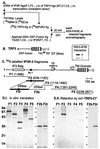Modulation of Ca(2+) entry by polypeptides of the inositol 1,4, 5-trisphosphate receptor (IP3R) that bind transient receptor potential (TRP): evidence for roles of TRP and IP3R in store depletion-activated Ca(2+) entry
- PMID: 10611319
- PMCID: PMC24754
- DOI: 10.1073/pnas.96.26.14955
Modulation of Ca(2+) entry by polypeptides of the inositol 1,4, 5-trisphosphate receptor (IP3R) that bind transient receptor potential (TRP): evidence for roles of TRP and IP3R in store depletion-activated Ca(2+) entry
Abstract
Homologues of Drosophilia transient receptor potential (TRP) have been proposed to be unitary subunits of plasma membrane ion channels that are activated as a consequence of active or passive depletion of Ca(2+) stores. In agreement with this hypothesis, cells expressing TRPs display novel Ca(2+)-permeable cation channels that can be activated by the inositol 1,4,5-trisphosphate receptor (IP3R) protein. Expression of TRPs alters cells in many ways, including up-regulation of IP3Rs not coded for by TRP genes, and proof that TRP forms channels of these and other cells is still missing. Here, we document physical interaction of TRP and IP3R by coimmunoprecipitation and glutathione S-transferase-pulldown experiments and identify two regions of IP3R, F2q and F2g, that interact with one region of TRP, C7. These interacting regions were expressed in cells with an unmodified complement of TRPs and IP3Rs to study their effect on agonist- as well as store depletion-induced Ca(2+) entry and to test for a role of their respective binding partners in Ca(2+) entry. C7 and an F2q-containing fragment of IP3R decreased both forms of Ca(2+) entry. In contrast, F2g enhanced the two forms of Ca(2+) entry. We conclude that store depletion-activated Ca(2+) entry occurs through channels that have TRPs as one of their normal structural components, and that these channels are directly activated by IP3Rs. IP3Rs, therefore, have the dual role of releasing Ca(2+) from stores and activating Ca(2+) influx in response to either increasing IP3 or decreasing luminal Ca(2+).
Figures






Comment in
-
TRP, inositol 1,4,5-trisphosphate receptors, and capacitative calcium entry.Proc Natl Acad Sci U S A. 1999 Dec 21;96(26):14669-71. doi: 10.1073/pnas.96.26.14669. Proc Natl Acad Sci U S A. 1999. PMID: 10611268 Free PMC article. No abstract available.
References
Publication types
MeSH terms
Substances
Grants and funding
LinkOut - more resources
Full Text Sources
Other Literature Sources
Molecular Biology Databases
Miscellaneous

